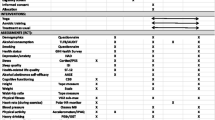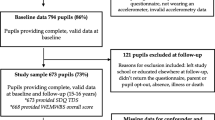Abstract
Aim
The aim was to investigate the association between psychosomatic problems and lifestyle patterns of alcohol use and physical exercise in adolescence.
Subject and Methods
Cross-sectional questionnaire data from 8 years of investigations (1988–2011) were used. The sample included over 20,000 adolescents (50 % girls), aged 15–16. Adolescents were divided into three groups depending on psychosomatic problem load: 10th, 11th–89th and 90th percentiles on the psychosomatic problems scale (PSP). A composite measure of alcohol use (frequent/rarely/never) and physical exercise (regular/little/never) was created, resulting in nine combinations of health-related behaviours, and used as dependent variable.
Results
Multinomial regression analysis showed that those over the 90th percentile of the PSP had nearly 12 times higher odds of regular alcohol use combined with no exercise compared with those who had the least symptoms. The former subgroup also had higher odds of belonging to all suboptimal lifestyle categories. Those in the 11th–89th percentiles had increased, albeit smaller, odds of belonging to all lifestyle categories. Descriptive data analysis indicated gender differences and changes over time in the strength of the association between psychosomatic problems and health-related behaviours but the regression analysis did not show any statistically significant interactions. The proportion of adolescents engaging in the unhealthiest lifestyle had decreased over time while reports of psychosomatic problems had increased.
Conclusion
Adolescents with the greatest psychosomatic symptom load were the most likely to engage in unhealthy lifestyles. This may mean multiplied risks of future psychopathology and warrants longitudinal investigations.
Similar content being viewed by others
References
American Psychiatric Association (2013) Diagnostic and statistical manual of mental disorders. American Psychiatric Publishing, Arlington, VA
Babic MJ, Morgan PJ, Plotnikoff RC, Lonsdale C, White RL, Lubans DR (2014) Physical activity and physical self-concept in youth: systematic review and meta-analysis. Sports Med 44:1589–1601
Balogun O, Koyanagi A, Stickley A, Gilmour S, Shibuya K (2014) Alcohol consumption and psychological distress in adolescents: a multi-country study. J Adolesc Health 54:228–234
Baron KG, Reid KJ, Zee PC (2013) Exercise to improve sleep in insomnia: exploration of the bidirectional effects. J Clin Sleep Med 9:819–824
Biddle SJH, Asare M (2011) Physical activity and mental health in children and adolescents: a review of reviews. Br J Sports Med 45:886–895
Bohman H, Jonsson U, Päären A, von Knorring L, Olsson G, von Knorring A-L (2012) Prognostic significance of functional somatic symptoms in adolescence: a 15-year community-based follow-up study of adolescents with depression compared with healthy peers. BMC Psychiatry 12:90
de Looze M, Raaijmakers Q, ter Bogt T, Bendtsen P, Farhat T, Ferreira M, Godeau E, Kuntsche E, Molcho M, Pförtner T-K (2015) Decreases in adolescent weekly alcohol use in Europe and North America: evidence from 28 countries from 2002 to 2010. Eur J Public Health 25:69–72
Fedewa MV, Gist NH, Evans EM, Dishman RK (2014) Exercise and insulin resistance in youth: a meta-analysis. Pediatrics 133:e163–e174
Gorka SM, Ali B, Daughters SB (2012) The role of distress tolerance in the relationship between depressive symptoms and problematic alcohol use. Psychol Addict Behav 26:621
Hagquist C (2008) Psychometric properties of the PsychoSomatic problems scale: a Rasch analysis on adolescent data. Soc Indic Res 86:511–523
Hagquist C (2015) Skolelevers psykiska hälsa. Nordic Welfare Centre, Stockholm
Hennings A, Schwarz MJ, Riemer S, Stapf TM, Selberdinger VB, Rief W (2013) Exercise affects symptom severity but not biological measures in depression and somatization: results on IL-6, neopterin, tryptophan, kynurenine and 5-HIAA. Psychiatry Res 210:925–933
Hills AP, King NA, Armstrong TP (2007) The contribution of physical activity and sedentary behaviours to the growth and development of children and adolescents. Sports Med 37:533–545
Hotopf M (2002) Childhood experience of illness as a risk factor for medically unexplained symptoms. Scand J Psychol 43:139–146
Hotopf M, Mayou R, Wadsworth M, Wessely S (1999) Childhood risk factors for adults with medically unexplained symptoms: results from a national birth cohort study. Am J Psychiatry 156(11):1796–1800
Hughes CW, Barnes S, Barnes C, DeFina LF, Nakonezny P, Emslie GJ (2013) Depressed adolescents treated with exercise (DATE): a pilot randomized controlled trial to test feasibility and establish preliminary effect sizes. Ment Health Phys Act 6:119–131
Huurre T, Lintonen T, Kaprio J, Pelkonen M, Marttunen M, Aro H (2010) Adolescent risk factors for excessive alcohol use at age 32 years: a 16-year prospective follow-up study. Soc Psychiatry Psychiatr Epidemiol 45:125–134
Jayakody K, Gunadasa S, Hosker C (2014) Exercise for anxiety disorders: systematic review. Br J Sports Med 48:187
Kalak N, Gerber M, Kirov R, Mikoteit T, Yordanova J, Pühse U, Holsboer-Trachsler E, Brand S (2012) Daily morning running for 3 weeks improved sleep and psychological functioning in healthy adolescents compared with controls. J Adolesc Health 51:615–622
Kassel JD, Jackson SI, Unrod M (2000) Generalized expectancies for negative mood regulation and problem drinking among college students. J Stud Alcohol 61:332–340
Kinnunen P, Laukkanen E, Kylmä J (2010) Associations between psychosomatic symptoms in adolescence and mental health symptoms in early adulthood. Int J Nurs Pract 16:43–50
Krumpal I (2011) Determinants of social desirability bias in sensitive surveys: a literature review. Qual Quant 47:2025–2047
Kushner MG, Sher KJ, Erickson DJ (1999) Prospective analysis of the relation between DSM-III anxiety disorders and alcohol use disorders. Am J Psychiatry 156(5):723–732
Lau RR, Quadrel MJ, Hartman KA (1990) Development and change of young adults’ preventive health beliefs and behavior: influence from parents and peers. J Health Soc Behav 31(3):240–599
Leifman H (2014) Skolelevers drogvanor. The Swedish Council for Information on Alcohol and other Drugs (CAN), Stockholm
Leifman H, Kühlhorn E, Allebeck P, Andréasson S, Romelsjö A (1995) Abstinence in late adolescence: antecedents to and covariates of a sober lifestyle and its consequences. Soc Sci Med 41:113–121
Lieb R, Zimmermann P, Friis RH, Höfler M, Tholen S, Wittchen H-U (2002) The natural course of DSM-IV somatoform disorders and syndromes among adolescents and young adults: a prospective-longitudinal community study. Eur Psychiatry 17:321–331
Liu M, Wu L, Ming Q (2015) How does physical activity intervention improve self-esteem and self-concept in children and adolescents? Evidence from a meta-analysis. PLoS One 10:e0134804
Lundborg P (2002) Young people and alcohol: an econometric analysis. Addiction 97:1573–1582
Merikangas KR, He J-P, Burstein M, Swanson SA, Avenevoli S, Cui L, Benjet C, Georgiades K, Swendsen J (2010) Lifetime prevalence of mental disorders in U.S. adolescents: results from the National Comorbidity Survey replication—adolescent supplement (NCS-a). J Am Acad Child Adolesc Psychiatry 49:980–989
Ortega FB, Ruiz JR, Hurtig-Wennlöf A, Sjöström M (2008) Physically active adolescents are more likely to have a healthier cardiovascular fitness level independently of their adiposity status. The European Youth Heart Study. Rev Esp Cardiol 61:123–129
Poikolainen K, Tuulio-Henriksson A, Aalto-Setälä T, Marttunen M, Lönnqvist J (2001) Predictors of alcohol intake and heavy drinking in early adulthood: a 5-year follow-up of 15–19-year-old Finnish adolescents. Alcohol Alcohol 36:85–88
Ruchkin V, Schwab-Stone M (2014) A longitudinal study of somatic complaints in urban adolescents: the role of internalizing psychopathology and somatic anxiety. J Youth Adolesc 43:834–845
Simons-Morton BG, Farhat T, Ter Bogt TFM, Hublet A, Kuntsche E, Gabhainn SN, Godeau E, Kokkevi A (2009) Gender specific trends in alcohol use: cross-cultural comparisons from 1998 to 2006 in 24 countries and regions. Int J Public Health 54:199–208
Stueve A, O’Donnell L (2000) Inconsistencies over time in young adolescents’ self-reports of substance use and sexual intercourse. Subst Use Misuse 35:1015–1034
Sweeting HN, West PB, Der GJ (2007) Explanations for female excess psychosomatic symptoms in adolescence: evidence from a school-based cohort in the west of Scotland. BMC Public Health 7:1
Tan VPS, Macdonald HM, Kim S, Nettlefold L, Gabel L, Ashe MC, McKay HA (2014) Influence of physical activity on bone strength in children and adolescents: a systematic review and narrative synthesis. J Bone Miner Res 29:2161–2181
Telama R, Yang X, Laakso L, Viikari J (1997) Physical activity in childhood and adolescence as predictor of physical activity in young adulthood. Am J Prev Med 13(4):317–323
Tompkins TL, Hockett AR, Abraibesh N, Witt JL (2011) A closer look at co-rumination: gender, coping, peer functioning and internalizing/externalizing problems. J Adolesc 34:801–811
Twisk JWR (2001) Physical activity guidelines for children and adolescents. Sports Med 31:617–627
Acknowledgements
This research was funded by a program grant from the Swedish Research
Council for Health, Working Life and Welfare (Forte) [2012-1736].
Author information
Authors and Affiliations
Corresponding author
Ethics declarations
Conflict of interest
The authors declare that they have no conflict of interest.
Research involving human participants
The ethical application was reviewed by the local ethics committee at Karlstad University and international ethical research standards were followed (e.g. current version of Declaration of Helsinki). Adolescents were informed about the study and that participation was voluntary. This article does not contain any studies with animals performed by any of the authors.
Informed consent
All individual participants included in the study had given their informed consent.
Rights and permissions
About this article
Cite this article
Norell-Clarke, A., Hagquist, C. Psychosomatic problems in relation to alcohol use and physical exercise: a study between 1988 and 2011 among adolescents in Sweden. J Public Health 24, 325–333 (2016). https://doi.org/10.1007/s10389-016-0729-4
Received:
Accepted:
Published:
Issue Date:
DOI: https://doi.org/10.1007/s10389-016-0729-4




